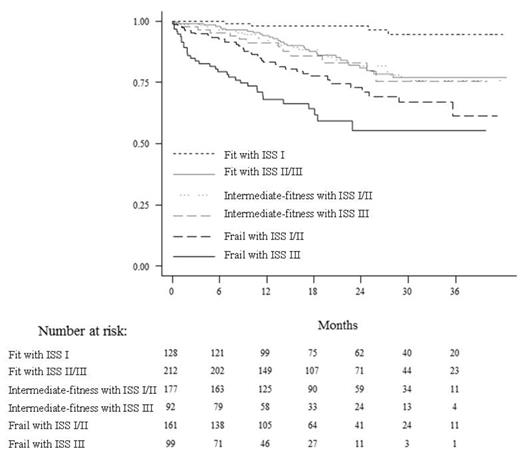Abstract

Background: Several biological parameters define patients with multiple myeloma (MM) at high-risk of progression or death. The well-known International Staging System (ISS), as well as age per se, are insufficient to explain differences of overall survival (OS) in patients over 65 years, who are 2/3 of newly diagnosed (ND) MM patients. We have recently showed that a frailty score combining age, functional status (Activity of Daily Living and Instrumental Activity of Daily living scores) and comorbidities (Charlson index) defines 3 categories of patients - fit, intermediate-fitness, frail - with significantly differences in OS and progression-free survival (Larocca A, et al. Blood 2013 122:687). Here we assess the causes of the different mortality in intermediate-fitness and frail groups compared to fit ones and present a final prognostic score based on the combination of ISS and frailty scores.
Methods: NDMM patients over 65 years enrolled in 3 clinical trials, receiving either lenalidomide, bortezomib or carfilzomib were included in the analysis. Details on treatment regimens and results of these studies have previously been reported (Palumbo A, et al. Blood 2013 122:536; Larocca A, et al. Blood 2013 122:539, Bringhen S et al. Blood 2014 Jul 3;124(1):63-9). The cumulative incidences of discontinuation and toxicities were calculated using the Fine & Gray model. The frailty score was combined with ISS with the CHi-squared Automatic Interaction Detector method used as an iterative decision tree.
Results: 869 patients (median age 74 years) were included in the analysis; 260 (30%) were frail, 269 (31%) intermediated-fitness and 340 (39%) fit. The 3-year OS was 57% in frail, 76% in intermediated-fitness and 84% in fit patients. Overall, 143 patients (16%) died, 70 (27%) frail, 39 (14%) intermediate-fitness and 34 (10%) fit. The causes of death were: disease progression [35 (13%) in frail, 22 (8%) in intermediate-fitness and 18 (5%) in fit patients] and toxicity [21 (8%), 10 (4%) and 11 (3%), respectively]. The higher risk of death for progression was related with the lower dose-intensity due to the higher rate of drug discontinuation and/or dose reduction. The average dose intensity was lower in frail (74%, p=0.0006) and intermediate-fitness patients (80%, p=0.07) compared with fit patients (85%). The cumulative incidence of drug discontinuation for any cause, excluding progression and death, was higher in frail (25%; HR 2.21, p<0.001) and intermediate-fitness (22%; HR: 1.41, p=0.052) patients compared with fit ones (17%). The most frequent reasons for toxicity-related death were cardiac events [11 (4%) in frail patients, 2 (1%) in intermediate-fitness, 3 (1%) in fit] and infections [8 (3%), 2 (1%) and 2 (1%), respectively]. When we combined the frailty score with the ISS, 6 groups of patients and 4 risk categories were identified: fit patients with ISS I at low risk (15%; 3-year OS: 94%), fit patients with ISS stage II or III and intermediate-fitness patients with ISS I, II or III at intermediate risk (55%; 3-year OS: 75-77%.), frail patients with ISS stage I or II at high risk (19%; 3-year OS: 61%) and frail patients with ISS stage III at very-high risk (11%, 3-year OS: 55%) (Figure 1).
Conclusion: The inferior survival observed among intermediate-fitness and in frail patients as compared to fit ones, is related to a higher rate of toxic deaths and disease progression, due to a lower dose intensity. The combination of the frailty score, evaluating the patient's status, and the standard ISS, taking into account the biological characteristics of the disease, can predict survival and enhances the single predictive values of the scores, thus representing a valuable tool for treatment-decision in the clinical practice.
Overall survival of patients classified into 6 categories according to the recursive partitioning analysis by combining the frailty score and the International Staging System.
Overall survival of patients classified into 6 categories according to the recursive partitioning analysis by combining the frailty score and the International Staging System.
Larocca:Janssen Cilag: Honoraria; Celgene: Honoraria. Off Label Use: Use off-label of lenalidomide (immunomodulatory drug), carfilzomib (proteasome inhibitor), subcutaneous bortezomib (proteasome inhibitor) in terms of schedule used and combination.. Bringhen:Onyx: Consultancy; Merck Sharp & Dohme: Membership on an entity's Board of Directors or advisory committees; Novartis: Honoraria; Janssen and Cilag: Honoraria; Celgene: Honoraria. Hajek:Janssen: Honoraria; Celgene: Consultancy, Honoraria; Merck: Consultancy, Honoraria. Offidani:Celgene: Honoraria; Janssen: Honoraria. Maracci:Mundipharma: Honoraria. Gay:Sanofi: Membership on an entity's Board of Directors or advisory committees; Janssen: Honoraria; Celgene: Honoraria, Membership on an entity's Board of Directors or advisory committees. Marasca:Janssen: Honoraria; Celgene: Honoraria. Giuliani:Celgene: Research Funding. Musto:Janssen: Honoraria; Celgene: Honoraria. Boccadoro:Sanofi: Consultancy, Membership on an entity's Board of Directors or advisory committees; Onyx: Consultancy, Membership on an entity's Board of Directors or advisory committees; Janssen-Cilag: Consultancy, Membership on an entity's Board of Directors or advisory committees; Celgene: Consultancy, Membership on an entity's Board of Directors or advisory committees. Sonneveld:Millenium: Honoraria, Research Funding; Onyx: Honoraria, Research Funding; Janssen: Honoraria, Research Funding; Celgene: Honoraria, Research Funding. Palumbo:Celgene: Consultancy, Honoraria; Janssen-Cilag: Consultancy, Honoraria; Millennium Pharmaceuticals, Inc.: Consultancy, Honoraria; Onyx Pharmaceuticals: Consultancy, Honoraria; Array BioPharma: Honoraria; Amgen: Consultancy, Honoraria; Sanofi: Honoraria; Genmab A/S: Consultancy, Honoraria; Bristol-Myers Squibb: Consultancy, Honoraria.
Author notes
Asterisk with author names denotes non-ASH members.

This icon denotes a clinically relevant abstract


This feature is available to Subscribers Only
Sign In or Create an Account Close Modal